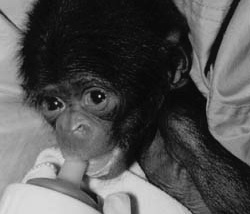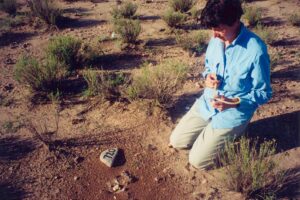Human tragedies often reverberate in unexpected ways, threatening environmental destruction and endangering other species. Consider the unfolding tragedy of the Congo, where continued fighting has caused the deaths of more than 1.7 million people in the past two years. Caught in the merciless crossfire of military forces from Uganda, Rwanda, and the Congo, villagers reportedly have fled into the jungle, where millions more now risk death from hunger, malaria, cholera, diarrheal diseases and H.I.V. Up to a third of those who have died so far are children under the age of five.

This human catastrophe cascades down to affect other species. In the case of the Congo, warfare has halted virtually all field research among pan paniscus, more commonly referred to as the bonobo, an ape which, like the chimpanzee, shares 98 percent of DNA
with us. Most of the estimated worldwide population of 20,000 bonobos live in contested zones south of the Congo River. Study of this animal, whose behavior contrasts in manifold ways with other higher apes, including chimpanzees and gorillas, enjoyed a boomlet in the 1980s. But long-term study projects on bonobos in the field now have been shut down. Scientists who specialize in the study of the bonobo also fear for the animal’s future.
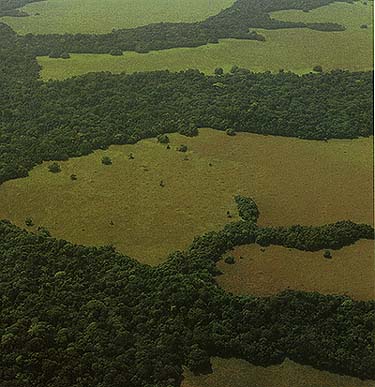
Although the bonobo has been protected for generations by indigenous cultural prohibitions against killing them, perhaps because of their resemblance to human beings, those inhibitions may well break down under current conditions. Villagers have been driven away from their agricultural plots and their livestock have been slaughtered. Against that backdrop, “the bush meat trade is a terrible threat,” says Frans De Waal, professor of primate behavior and director of the Living Links Center at Emory University in Atlanta. “It’s part of a worldwide conservation crisis. But it’s particularly frustrating because we don’t really know what’s happening. The people who were studying the bonobos, who could have told us what is happening to them, have all been forced to leave.”
The shutdown in field research on bonobos is particularly lamentable because these primates exhibit such distinct behavior patterns. They are smaller than chimpanzees, more playful, and they often stand on two feet when walking. Bonobos are female-centric and their social organization orbits around lifelong ties between mothers and sons. Unlike chimpanzees and gorillas, which have been studied far more extensively, the social organization of bonobos is not male-dominated and the relationship patterns appear far more egalitarian than among other apes.
“…Bonobos did not adopt a more gorillalike social organization in which a number of females are led by a male who competes with other males for their ‘possession,’” De Waal writes in his seminal work, Bonobo: The Forgotten Ape (U.C. Press: 1997). “The bonobo seems to have followed almost the opposite evolutionary path.”
Bonobos differ from other primates in surprising ways. Strong bonds between females are a key feature of bonobo culture. Infanticide, which is widely practiced by dominant males among other apes, is apparently non-existent among the bonobos. De Waal says that the current shutdown in field research makes it difficult to confirm this apparent prohibition against infant killing, and cuts off intriguing avenues for research into the treatment of bonobo young. There may be a link between strong female bonds and the low prevalence of infanticide, according to De Waal and other researchers.
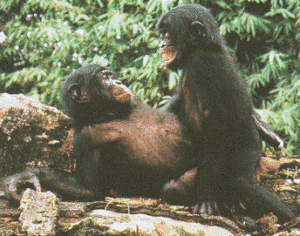 Sex patterns among bonobos also reveal remarkable patterns of behavior. Bonobos engage in carefree erotic exchanges of unusual frequency and form. Face-to-face mating was once considered a distinctly human activity, but male and female bonobos often use the “missionary position,” according to field studies and captive animal observation in zoos around the world. Bonobos also engage in polymorphous pleasures, including erotic rubbing between females, penis fencing among males, cross-generational sex play, group eroticism, and French kissing.
Sex patterns among bonobos also reveal remarkable patterns of behavior. Bonobos engage in carefree erotic exchanges of unusual frequency and form. Face-to-face mating was once considered a distinctly human activity, but male and female bonobos often use the “missionary position,” according to field studies and captive animal observation in zoos around the world. Bonobos also engage in polymorphous pleasures, including erotic rubbing between females, penis fencing among males, cross-generational sex play, group eroticism, and French kissing.
“The bonobo is a sexual Olympian,” writes Natalie Angier in Woman, An Intimate Geography. “Males, females, old, callow, no matter — it’s sex, grope, hump, genito-genital rub-a-dub-dubbing, all the day long.”
Researchers believe that sex for the bonobos is a kind of substitute, in resolving disputes, for the kinds of aggressive displays which more widely mark chimpanzee and gorilla life. De Waal writes: “Who could have imagined a close relative of ours in which female alliances intimidate males, sexual behavior as rich as ours, different groups do not fight but mingle, mothers take on a central role, and the greatest intellectual achievement is not tool use but sensitivity to others? Any scientist proposing such a list of traits as even remotely likely in a member of our immediate lineage would have been laughed out of the halls of academe in the 1960s.”
The course of scientific research is shaped by cultural assumptions. De Waal and other researchers believe that studies of non-human primate behavior might have developed quite differently if the social organization of bonobos had been more widely understood. After World War II, De Waal says, the emphasis on aggression as the central organizing principle of non-human primate life fit in with a rather gloomy view of human nature. “We wanted to hear from biologists that we have this murderous tendency,” De Waal explains. Behaviorists with a contrary view, who emphasized the peaceful cast of ape life, were “wiped out,” De Waal says, by Jane Goodall’s reports, in the late 1970s, of murderous episodes among chimpanzees.
Bonobos provide a kind of corrective, De Waal implies, for the previous overemphasis on aggression and murderousness which marked most scholarship concerning apes. “The bonobo shows an unparalleled social organization that should give pause to anyone claiming the universality of certain traits in our ancestry,” De Waal writes. “If two relatives such as bonobos and chimpanzees differ so greatly, this hints at flexibility in our lineage — not just in a cultural sense, but also evolutionarily — that many of us had not held possible.”
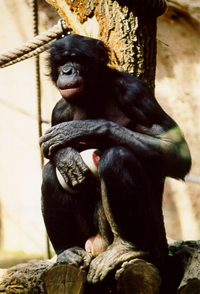 In the study of non-human primates like bonobos, both in the wild and in captivity, anthropomorphism — that is, the tendency to ascribe human traits to another animal — provides an especially difficult challenge for researchers. “There is no escape, we are looking at an animal so akin to ourselves that the dividing line is seriously blurred,” De Waal writes.
In the study of non-human primates like bonobos, both in the wild and in captivity, anthropomorphism — that is, the tendency to ascribe human traits to another animal — provides an especially difficult challenge for researchers. “There is no escape, we are looking at an animal so akin to ourselves that the dividing line is seriously blurred,” De Waal writes.
De Waal maintains, however, that this impulse to identify with an animal that one is studying, should not become an obstacle for the conscientious scholar. “There are three kinds of anthropomorphism,” De Waal says. “One is actually anthropocentric: You see a male bear and a female bear together and you say, ‘Oh they must love other,’ even though bears don’t have that kind of couple relationship. Projecting human feelings without any critical distance can be a problem. But there’s another kind of anthropomorphism that’s animal-centric: I give meal worms to the monkeys I’m working with, and I say, ‘Oh, that’s so good’ as if I think so, even though I would never eat them. I’m looking at the world from the perspective of my monkeys. That’s an enormously powerful way of observing and studying. The closer the animal is to you in evolutionary terms, the more powerful is this method.”
De Waal’s research now centers on studies of reciprocity, forgiveness, and natural conflict resolution. He and his students are studying chimpanzees, bonobos, macaques, and capuchin monkeys in major zoos and research centers, to watch how animals share food and grooming duties; recognize one another; and repair tensions among themselves after outbreaks of aggression.
This spring, De Waal’s bonobo research came under sustained attack from anthropologist Craig Stanford in an issue of American Scientist. Stanford claimed that the portrait of bonobos presented by De Waal and others had been overdrawn. Chimpanzees and bonobos, Stanford asserted, are far more alike than scholars had supposed. He even suggested that the sharp differences reported by researchers like De Waal were an artifact of observation of the animals in captive settings. Captive populations, no matter how naturalistic the setting, Stanford argued, couldn’t substitute for field observation.
De Waal replied with an aggrieved letter in the June American Scientist, pointing out that 25 years of field work by Dr. Takayoshi Kano at Wamba, a study site established by the University of Kyoto, supported researchers’ findings based on observations of captive bonobos. “Stanford takes the position that the differences are not so great,” De Waal says. “But he’s never studied them himself, so he’s simply unable to believe what we say.”
But about Stanford’s underlying point — that direct observation of bonobos in the field would be helpful in teasing out the implications of bonobo behavior — De Waal finds himself in doleful agreement. Observation in the wild would be an important complement to studies of captive animals. But, of course, field work of the sort which might resolve the differences among scholars is no longer possible, because of the ongoing crossfire in the Congo.
©2002 Douglas Foster
Douglas Foster is a freelance writer in Berkeley, CA studying animal behavior.

